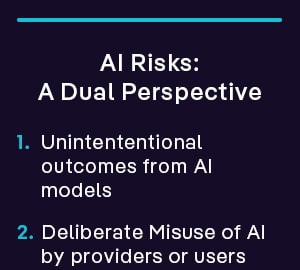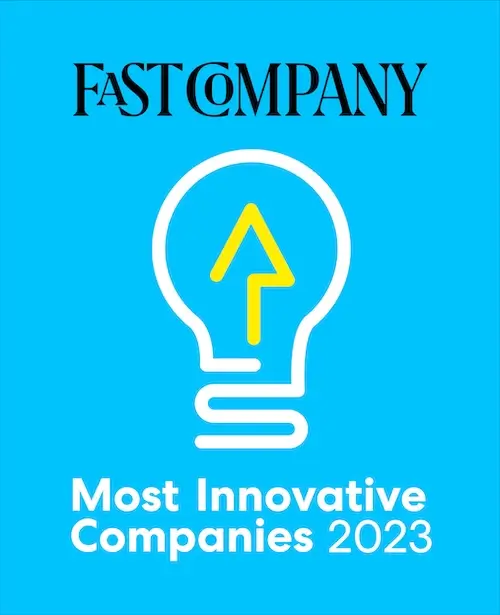In the evolving landscape of artificial intelligence (AI), machine learning, and related technologies, artificial intelligence regulations, and legislation like the EU AI Act and US Executive Order on Safe, Secure, and Trustworthy AI, stand as a testament to the critical crossroads we find ourselves at. The involvement of governments illuminates the importance of steering AI towards safe and responsible use. Generative AI brings with it numerous opportunities and risks, which calls for reflection and action from all sectors: governments, organizations, and users, as we move forward into the new era.
AI Guardrails: A Proactive Blueprint for Tomorrow 
The adage “with great power comes great responsibility” rings especially true in the realm of AI development. As organizations and leaders, in AI technology, it’s vital that we create clear guidelines for AI right from the start, not as an afterthought, but as a foundation of AI creation, deployment, and use— to avoid unintended consequences. These guidelines are not just for safety but also for long-term success. By setting these protections in place now, businesses are not just preparing for a distant future; they are sculpting it.
Lead by Example: Business Sectors’ Role in Shaping AI
Government policies often lag behind technological innovation. While policies are crucial, the leadership within the business sector, the innovators, product leaders, and data scientists can truly set the tone for the AI journey. We are on the front lines, building and employing these technologies, witnessing their impact, and understanding their intricacies. It is our prerogative—our opportunity—to lead the charge in responsible AI usage, embedding ethical considerations into our products’ DNA and strategies.
The Importance of Governance and Guardrails
Governance mechanisms that ensure responsible use of AI are not a choice; they are a necessity. Strong governance helps protect against AI misuse, cyber threats, privacy breaches, and misleading content. Implementing and following guardrails ensures the creation of safe and trustworthy AI models.
These guardrails enables safe and trustworthy models and can create differentiation for AI and AI-driven product providers. Additionally, it creates the foundational trust for organizations adopting AI by ensuring that the value of AI can be realized while introducing minimal risk into their organization.
At ContractPodAi, we build our GenAI features with a guardrails-first mindset. We formulated our guardrails and published them before formulating or releasing any AI-driven products, and of course, they are ever-evolving as we target new legal use cases. The guardrails are not nice to have for us; they are fundamental to ensure we offer best-in-class legal solutions to our customers that they can trust and provide them with essential privacy and security.
AI Risks: A Dual Perspective
AI Risks are two-fold: unintentional outcomes from AI models and the deliberate misuse of AI by providers or users. These risks, however, can be managed. Like guardrails on a winding road, proactive measures can guide the AI journey safely. Data governance is critical for ethical implications around AI.
The principles of training an AI model are not significantly different from a child’s behavioral development; the quality and accuracy of training data the model is exposed to directly impact the behavior and output. We foster fair and balanced outputs and protect sensitive data and personal information by ensuring AI models are exposed to diverse, unbiased, and accurate data.
Domain-Specific Guardrails and Risk of Indirect Bias
Regulations and guardrails are needed to build safety, security and offer trustworthy AI. However, how they are formulated and governed is critical to prevent indirect bias. As an example, in AI data model training, a series of data points, such as gender and race, can result in creating biased AI and social scoring in general-purpose large language models. These are the occurrences, such as the country-specific AI-generators like Barbies, that are frequently mentioned in the news and media. However, on the other hand, the same data points could be critical in training a medical model that could potentially save lives. General-purpose AI product usage needs to have guardrails to prevent misuse and ensure data privacy, but defensive products also need to be built to identify and prevent harm.
As a result, guardrails and regulations are not a One-Size-Fits-All. They need to be domain-specific and carefully drafted to create opportunities, provide security, and prevent harm. These considerations highlight the crucial role of regulations and guardrails to ensure AI serves its purposes without inadvertently perpetuating biases or causing harm.
The Future of AI
The efforts to regulate AI serve as a call to industry leaders to pave the way—by establishing trusted, secure, and equitable AI. By embracing this opportunity, organizations can set themselves apart and encourage innovation that is not just technologically advanced but also ethically sound and socially responsible. The future of AI should not be passively observed but actively shaped by the decisions we make today.











